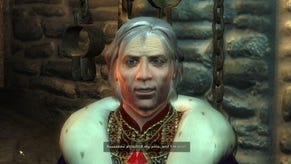PS1 at 20: Lara Croft ran for the student union at my university
Toby or not Toby.
This week marks the 20th anniversary of PlayStation in the UK. Over the next few days, we're reminiscing about our favourite games for Sony's first console.
Lara Croft ran for the student union at my university. She probably did at yours, too, if you went into higher education in the mid-1990s. For one term, she was everywhere: on the cover of Face, yes, but also photocopied and hand-cut and plastered all over the walls around campus, trampled underfoot by the payphones and hanging off the ceiling tiles in the corridor leading up to the bar. She was perfect for this kind of work, which probably explains why there were actually multiple Lara Crofts running for positions in the union that year, twin pistols driving home the message that she would get us all subsidised beer, even if she had to shoot a tiger or two to make that happen.
That Lara Croft is not quite the Lara Croft. It strikes me that in the first game, she is not quite the way she ended up later on - even before she was rebooted into Nolan territory with a weeping set of impalement wounds and a backstory after-work job at the local boozer. Lara Croft in the first game was angular, fierce and slightly sinister. She wore those round-lensed glasses everywhere as if she was in the background of a Belly video, and in advertising images she often had a rather frightening crocodile smile to go with them. Lara could always handle herself, but this first one really looked like she enjoyed the crueller aspects of raiding tombs and dispatching wildlife. This one suggested that Croft Manor might be full of illegal furs, and that she would sell any loot she found to the highest bidder, sourcing nick-knacks for terrifying men in awful regimes.
And yes, I know that Tomb Raider is an obvious choice for a treasured PS1 game, and I even know that, actually, all the cool kids played it on the Saturn. That's the point, though. I had completely dropped out of games by the time the PS1 came around, and Tomb Raider turned out to be the way back in.

A friend bought a machine second hand. I'd love to be able to tell you it was one of those early PS1s that you had to turn upside down to get it to play, but it was boringly competent, alas. It's probably still working today. It came with a bunch of games, nearly all of them hilariously, almost subversively shit, but it also had Tomb Raider, and Tomb Raider was something else.
It was what everyone hopes a big game on a new machine will be like: a message from the future, telling me that the medium had changed forever. I had seen 3D games before I dropped out of the scene, but not real 3D games. I had spied Donkey Kong Country, with its 3D models, running in the window of a games store and thought: that looks naff - sheeny and cheap and throwaway. Suddenly, though, Tomb Raider was creating worlds that would only really work in 3D. She travelled through caverns and canyons as well as corridors. You still had to jump - I could just about grasp that this was a platformer - but you had to jump inwards, outwards, into the abyss.

Tomb Raider also told me that games were no longer perfect - that you had to accept compromises in order to travel to these strange new places. 2D games at this point had achieved astonishing things, and in the flat confines of their reality, they could depict almost anything with precision and wit. Their worlds were coherent and consistent and uncompromised, as long as you could accept the fact that they were all set along a single plane.
Tomb Raider, by contrast, actually looked kind of ropey. Sure it was 3D, but everything was so angular and alien. I remember that when you ran through a narrow corridor in the first Tomb Raider, the polygons along the very edges of the walls would break down and you would get this jagged black line as a kind of frame. To someone used to 2D games and the careful way they would present themselves, this was sort of horrifying. The future looked so ragged. (Back then, I particularly hated the way that the camera would clip through objects, like a bad actor accidentally taking some of the scenery with them as they stomp off-stage.)
But the truth was in the playing. Tomb Raider used 3D not to wow you with graphics, which is why I never really remember the T-Rex bit which everyone used to go nuts about, but to ground you in environments that felt impossibly vast yet also real and tangible. Tomb Raider took you places - to crumbling temples and a golden Sphinx, buried and intact. And while you were there, you were so graceful! Graceful in a way that the controls would never initially suggest. That sideways leap, legs tucked up, toes pointed! Lara Croft lost quite a bit when that was rebooted out of her.
She was never more whole than she was back at the start, really: when it was terribly hard to make her out, and when there was no real backstory to speak of, and little need for it. She was here to do one thing: to show us the future - and it played like a dream.








